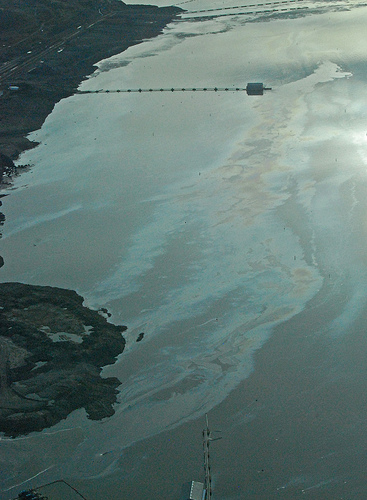By Joe Johnson (The Cascade) – Email
Print Edition: February 8, 2012
As pressure increases to export the Athabascan oil sands in northern Alberta, tensions are heating up. In what may be described to be one of Western Canada’s greatest environmental and economic battles, events are quickly unfolding.
It began when the decision on the Keystone XL pipeline, that was meant to route the oil from the oil sands into the USA, was postponed by the American government. Quickly on its heels, though, was a proposal by Enbridge with their Northern Gateway pipelines.
The $5.5 billion Northern Gateway project would see the raw form of oil, called bitumen, piped westward across 1177 km to BC’s coast in Kitimat – opening up the coastline for the first time to massive oil tankers. Most of this is designed for the Asian market, more specifically China. A second pipe, in the opposite direction, would carry a natural gas condensate.
Given that the coastal area around Kitimat is notoriously difficult to navigate, and that the 525,000 barrels per day of oil would have to cross over 1000 rivers, waterways, as well as aboriginal lands, this proposal is not one that will be given the green light without lengthy deliberation.
It was then decided by the government to obtain approval through the National Energy Board (NEB), an independent regulatory tribal wing of the federal government.
At the NEB a joint review panel will weigh the benefits and risks of the pipeline. It first begins by holding a moving hearing process across different cities where advocates and opponents will both raise concerns and opinions. At this point, 4300 people have enlisted to speak. This process could last into 2013. When the hearings are over, a report will be released which will include, according to the NEB, “the Panel’s rationale for its conclusions and recommendations.” As well as “any mitigation measures, follow-up programs and a summary of comments received from participants.” The federal government can then review these findings and make their choices, before going back to the NEB for a final decision.
Currently, it is at the hearing stage and all sides have come out to have their voices heard. Environmentalists, aboriginals, economists, the federal and provincial governments, and lobbyists are doing their best to influence the panel. The media has also played a role in unearthing issues such as control of oil sands ownership.
From the environmentalists standpoint, the case is shaped in a “when, not if” point-of-view in terms of accidents. Enbridge has had a history of oil spills, most recently when, in Illinois, a ruptured pipe released an estimated 6100 barrels of oil. If this were to happen in BC, there could be an effect on the wild life, as well as drinking water.
Roughly 1000 First Nations’ people took to the streets of Prince Rupert on the weekend to protest the pipeline. They too are mainly concerned with the potential environmental impacts.
With regards to economics, recently Robyn Allan—a leader in her field and previous ICBC CEO—submitted a report to the NEB, which cast the project in a negative light. She raised a significant point on the project’s limited benefits for Canadians as she stated, “Northern Gateway represents an inflationary price shock which will have a negative and prolonged impact on the Canadian economy by reducing output, employment, labour income and government revenues.” “With the pipeline in place, Canadians will pay $2 to $3 more for every barrel of crude oil purchased in Canada, than without the pipeline – on every barrel, every year, for the next 30 years,” Allan said.
An opposing view to Allan’s is that the returns made on the open market will more than offset the costs, and that the increase in per barrel cost won’t be reflected at the gas pump.
But it’s her point on the government which resonates with a lot of the issues left in the shadows, “Northern Gateway means lost opportunity to create a long term energy security strategy for Canadians. It also represents a lost opportunity to ensure reasoned and sustainable development of crude oil resources that captures real value added in an environmentally responsible manner for the benefit of all Canadians.”
Her report became even more political when she said, “Canada’s federal and provincial leaders have abdicated their responsibility for meaningful energy policy by endorsing Northern Gateway, and have willingly stepped aside while the value added potential of our raw resources is sold-short on the international market. From a public policy standpoint, Canada is being outplayed.”
In the political backstage Allan suggested that much of the focus has been on the media. To start, aside from lobby groups such as Ethical Oil, the federal government, namely Stephen Harper, Natural Resources Minister Joe Oliver and Premier Christy Clark, insist that the large number speaking out against the pipeline is in part a plan by “foreign special interest” trying to choke the system, calling them “radical groups.”
While it’s said by supporters that the pipeline could increase domestic GDP by $270 billion, it has been pointed out through different mainstream media outlets that a significant percentage of ownership of the oil sands companies is being bought by foreign businesses and in some cases foreign nationally-owned businesses. Yet, if we increase our export availability for foreign ownership, the big winners are the foreign multinationals who would then own Canada’s production and exports of oil-based energy.
Not to be lost in all of this is the public opinion. Commissioned by Enbridge, an Ipsos-Reid poll found close to 50 per cent of the people of BC support the pipeline.


